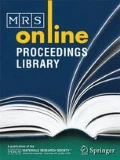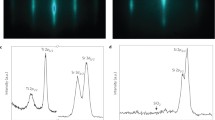Abstract
We report on an integrated photoelectrochemical (PEC) device for hydrogen production using amorphous silicon carbide (a-SiC:H) material as the photoelectrode in conjunction with an amorphous silicon (a-Si:H) tandem photovoltaic device. With the use of a-Si:H tandem solar cell, the flat-band potential of the hybrid PEC structure shifts significantly below the H2O/O2 half-reaction potential and is in an appropriate position to facilitate water splitting. Under reverse bias, saturated photocurrent of the hybrid device ranges between 3 to 5 mA/cm2 under AM1.5 light intensity. In a two-electrode setup (with ruthenium oxide counter electrode), which is analogous to a real PEC configuration, the hybrid cell produces photocurrent of about 0.83 mA/cm2at zero bias and hydrogen production is observed. The hybrid device exhibits good durability in pH2 buffered electrolyte for up to 150 hours (so far tested).
Similar content being viewed by others
References
T. Ohta “Solar-Hydrogen Energy Systems”, (Pergamon Press, 1979).
R. Narayanan and B. Viswanathan “Chemical and Electrochemical Energy Systems”, (University Press, India, 1998).
A. Stavrides, A. Kunrath, J. Hu, R. Treglio, A. Feldman, B. Marsen, B. Cole, E.L. Miller and A. Madan Proc. SPIE, Vol. 6340, 63400K (2006).
F. Zhu, J. Hu, A. Kunrath, I. Matulionis, B. Marsen, B. Cole, E.L. Miller and A. Madan Proc. SPIE, Vol. 6650, 66500S (2007).
J. Hu, F. Zhu, I. Matulionis, A. Kunrath, T. Deutsch, L. Kuritzky, E. Miller and A. Madan Proc. 23rd European Photovoltaic Solar Energy Conference, 69 (2008)
K. Varner, S. Warren and J. A. Turner Proceedings of the 2002 U.S. DOE Hydrogen Program Review, NREL/CP-610-32405.
J. Tauc “Amorphous and liquid semiconductor” (Plenum, New York, 1974) p.159
A. Madan and M.P. Shaw “The Physics and Applications of Amorphous Semiconductors”, (Academic Press, 1988) p. 99.
R.E. Hollingsworth, P.K. Bhat, and A. Madan, Proc. 19th IEEE PVSC, 684 (1987).
R. Memming “Semiconductor Electrochemistry”, (Wiley-VCH, 2001).
Statement of Project Objectives, US Department of Energy, #DE-FC36-07GO17105; See also R. Garland {etet al.}, DOE Hydrogen Production Review Meeting, Arlington, VA, June 12, 2008.
Acknowledgments
The work is supported by US Department of Energy under contract number DE-FC36- 07GO17105. The authors would like to thank Ed Valentich for his assistance in sample fabrication, J. Gallon for his assistance in conductivity activation energy measurement and Dr. A. Kunrath for helpful discussions.
Author information
Authors and Affiliations
Rights and permissions
About this article
Cite this article
Hu, J., Zhu, F., Matulionis, I. et al. Development of a hybrid photoelectrochemical (PEC) device with amorphous silicon carbide as the photoelectrode for water splitting. MRS Online Proceedings Library 1171, 29–34 (2009). https://doi.org/10.1557/PROC-1171-S03-05
Published:
Issue Date:
DOI: https://doi.org/10.1557/PROC-1171-S03-05




